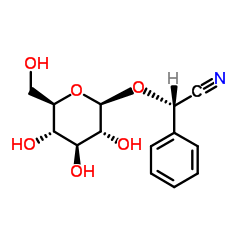野黑樱苷

野黑樱苷结构式

|
常用名 | 野黑樱苷 | 英文名 | Prunasin |
|---|---|---|---|---|
| CAS号 | 99-18-3 | 分子量 | 295.29 | |
| 密度 | 1.5±0.1 g/cm3 | 沸点 | 527.0±50.0 °C at 760 mmHg | |
| 分子式 | C14H17NO6 | 熔点 | 138-148ºC | |
| MSDS | 中文版 美版 | 闪点 | 272.5±30.1 °C | |
| 符号 |


GHS06, GHS08 |
信号词 | Danger |
|
Chromatographic determination of cyanoglycosides prunasin and amygdalin in plant extracts using a porous graphitic carbon column.
J. Agric. Food Chem. 50(24) , 6960-3, (2002) The determination of cyanogenic compounds in plants is often performed by HPLC. However, in this analysis, interferences due to compounds in the matrix, such as tannins and other pigments, are encountered, especially in roots and leaves. A new method is propo... |
|
|
Larvae of the fall webworm, Hyphantria cunea, inhibit cyanogenesis in Prunus serotina.
J. Immunol. Methods 211 , 671-7, (2008) The larvae of the fall webworm, Hyphantria cunea (Dru.), though vulnerable to cyanide poisoning, consume the cyanogenic leaves of black cherry, Prunus serotina, without apparent harm. The cyanide contents of leaves, defensive regurgitant, the bolus, and frass... |
|
|
Generation of primary amide glucosides from cyanogenic glucosides
Phytochemistry 70(3) , 388-93, (2009) The conversion of the cyanogenic glucoside prunasin into the corresponding prunasinamide has been observed in the leaves of Olinia ventosa and other prunasin-containing species only if reactive oxygen species were produced. In vitro, pure prunasin was quickly... |
|
|
Natural glycosides containing allopyranose from the passion fruit plant and circular dichroism of benzaldehyde cyanohydrin glycosides.
Org. Lett. 3(14) , 2193-5, (2001) [structure: see text] Leaves of the edible passion fruit plant, Passiflora edulis, contain benzylic beta-D-allopyranosides 1 and 2, representatives of a rare class of natural glycosides with D-allose as the only sugar constituent. The glycoside 1 is the first... |
|
|
Characterisation of galloylated cyanogenic glucosides and hydrolysable tannins from leaves of Phyllagathis rotundifolia by LC-ESI-MS/MS.
Phytochem. Anal. 22(6) , 516-25, (2011) Phyllagathis rotundifolia (Jack) Bl. (Melastomataceae) is a creeping herb found in Peninsular Malaysia and Sumatra. Traditionally, a decoction of the leaves is used in the treatment of malaria, fever and stomach ache.To provide ESI-MS(n) data which are applic... |
|
|
Cloning, sequencing, and characterization of a membrane-associated Prevotella ruminicola B(1)4 beta-glucosidase with cellodextrinase and cyanoglycosidase activities.
J. Bacteriol. 177(20) , 5884-90, (1995) Prevotella ruminicola B(1)4 is a gram-negative, anaerobic gastrointestinal bacterium. A 2.4-kbp chromosomal fragment from P. ruminicola encoding an 87-kDa aryl-glucosidase (CdxA) with cellodextrinase activity was cloned into Escherichia coli DH5 alpha and seq... |
|
|
Inhibitory effect of amygdalin on lipopolysaccharide-inducible TNF-alpha and IL-1beta mRNA expression and carrageenan-induced rat arthritis.
J. Microbiol. Biotechnol. 18(10) , 1641-7, (2008) Amygdalin is a cyanogenic glycoside plant compound found in the seeds of rosaceous stone fruits. We evaluated the antiinflammatory and analgesic activities of amygdalin, using an in vitro lipopolysaccharide (LPS)-induced cell line and a rat model with carrage... |
|
|
Kinetic analysis of hexose transport to determine the mechanism of amygdalin and prunasin absorption in the intestine.
J. Appl. Toxicol. 23(5) , 371-5, (2003) Evidence is accumulating that glucose-conjugated compounds may be carried across the gut mucosa via the epithelial sodium-dependent monosaccharide transporter SGLT1. A modification of the everted intestinal sac technique was utilized to study the transport of... |
|
|
Metabolites of amygdalin under simulated human digestive fluids.
Int. J. Food Sci. Nutr. 61(8) , 770-9, (2010) In the present study, degradation of amygdalin in the human digestive fluids and absorption of its metabolites by the human small intestine were evaluated by simulating a gastrointestinal digestion model combined with a human intestinal cell culture. Orally a... |
|
|
Heterocyclic compounds from Chrysanthemum coronarium L. and their inhibitory activity on hACAT-1, hACAT-2, and LDL-oxidation.
Arch. Pharm. Res. 31(5) , 573-8, (2008) The aerial parts of Chrysanthemum coronarium L. were extracted with MeOH, and the concentrated extract was partitioned using EtOAc, n-BuOH, and H(2)O, successively. Repeated column chromatography of the EtOAc and n-BuOH fractions gave a new heterocycle, 5,5'-... |